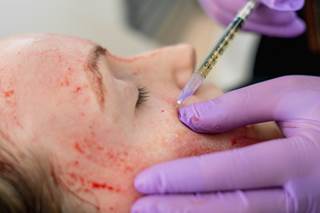
Participants noted improvements in facial texture and wrinkles after injections of platelet-rich plasma.
Platelet-rich plasma (PRP) injections may at least temporarily improve texture of photoaged skin compared with saline injections, according to a study recently published in JAMA Dermatology.
In this parallel, split-face, randomized clinical trial with 1:1 allocation, participants and raters were masked to participant groupings. Nineteen participants between the ages of 18 and 70 years with bilateral cheek rhytids of Glogau class II or greater received 3 mL intradermal injections of PRP to 1 cheek and 3 mL sterile normal saline injections in the contralateral cheek. Injections were placed 1 cm apart at the level of the mid-dermis with a 25-gauge needle in aliquots of 0.02 mL per puncture from the zygomatic area to mandibular area and from the nasolabial folds to the preauricular area. Digital photographs taken at 2-week and 3-month follow-up visits were compared with baseline digital photographs by 2 dermatologists who assigned photoaging scores. Participants also completed self-assessment questionnaires and adverse events were recorded at all follow-up visits. Additionally, at 6 months, patients completed an overall satisfaction questionnaire, and a telephone follow-up was conducted at 12 months.
Mean photoaging scores, based on ratings from the 2 dermatologists, showed no significant difference between PRP and normal saline for all clinical variables, which included fine lines, mottled pigmentation, roughness, and sallowness. Participants rated the PRP-treated side after 6 months of injections as significantly more improved compared with the saline-treated side for texture (mean [SD] self-assessment score, 2.00 [1.20] vs 1.21 [0.54]; P =.02) and wrinkles (mean [SD] self-assessment score, 1.74 [0.99] vs 1.21 [0.54]; P =.03). Self-assessment scores for pigmentations and telangiectasias were nominally but not significantly improved. No serious adverse events were reported.
Early patient termination and low sample size was a limitation of this study; multiple sessions of PRP injections arguably could produce a greater cumulative benefit.
The study researchers concluded that PRP may reduce visible signs of photoaging in patients seeking facial rejuvenation but larger studies are needed for further analysis.
Disclosures: One author declares associations with the pharmaceutical industry. Please see original reference for a full list of authors’ disclosures.
Reference
Alam M, Hughart R, Champlain A, et al. Effect of platelet-rich plasma injection for rejuvenation of photoaged facial skin: a randomized clinical trial [published online November 7, 2018]. JAMA Dermatol. doi:10.1001/jamadermatol.2018.3977